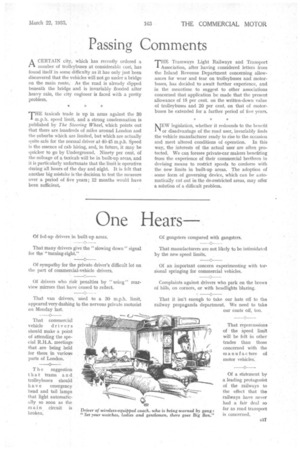One Hears-
Page 31

If you've noticed an error in this article please click here to report it so we can fix it.
Of fed-up drivers in built-up areas.
That many drivers give the "slowing down" signal for the " turning-right."
Of sympathy for the private driver's difficult lot• on the part of commercial-vehicle drivers.
Of drivers who risk penalties by " using " rearview mirrors that have Ceased to reflect.
That van drivers, used to a 30 m.p.h. limit, appeared very dashing to the nervous private motorist on Monday last.
That commercial vehicle drivers should make a point of attending the special R.H.A. meetings that are being held for them in various parts of London.
The suggestion that trams and trolleybuses should Ii ave emergency head and tail lamps that light automatically so soon as the main circuit is broken, Of gongsters compared with gangsters.
That manufacturers are not likely to be intimidated by the new speed limits.
Of an important concern experimenting with torsional springing for commercial vehicles.
Complaints against drivers who park on the brows of hills, on corners, or with headlights blazing.
That it isn't enough to take our hats off to the railway propaganda department. We need to take our coats off, too.
That repercussions of• the speed limit will be felt in other trades than those concerned with the manufacture of motor vehicles, Of a statement by a leading protagonist of the railways to the effect that the railways have never had a fair deal so far as road transport is concerned.




























































































